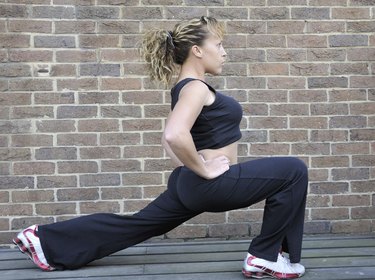
Lunges strengthen the glutes, quadriceps, hamstrings, core and stabilizing muscles of the leg -- while also challenging your cardiovascular system. The lunge is an exercise that works the entire lower body and emphasizes joint mobility, strength and flexibility, according to Boston Performance Coaching. The lunge also requires mobility in the hip, which can lead to hip pain if not performed properly. Understanding your body and the mechanics of performing a lunge can help reduce your risk of hip pain from lunges.
Role of the Hip During a Lunge
Video of the Day
The hip flexors are a group of muscles at the front of your hip, including the rectus femoris, psoas major and illiacus. These muscles are used in the raising up of the leg or moving the knee up toward the chest. During a lunge, the hip flexor area is stretched, placing tension on the muscles. The hip flexors are recruited if the abdominal area is weak and unable to stabilize your body during a lunge.
Video of the Day
Hip Tightness
The hip muscles become shortened and tightened due to prolonged sitting as well as repetitive activities, such as cycling, where the hip is in a contracted position. This shortening of the hip flexors lead to inflexibility in the hip and a higher likelihood of injury due to over-stretching or straining of the area. During a lunge, the hip on the back leg is in a stretched position. If the hip is already shortened, this stretch could lead to an over-stretching or strain in the hip.
Performing a Lunge
Performing a lunge incorrectly can also lead to hip pain. A common mistake in performing a lunge is to lean forward, bringing the knee over the toe. This creates strain in the knee and hips and can lead to pain. When performing a lunge, keep weight in the heel of the front foot and the knee in line with the heel. It is also important to keep your upper body as upright as possible. Excessive forward lean, which often happens as a result of a weak core, contributes to pain and strain due to improper form.
Lunge Modifications
If you do have hip pain when performing a lunge, you can modify lunges to place less stress on the body. One modification is to perform a lunge and only lower halfway down, lessening the stress and strain on your legs. Holding a prop, such as a bench or chair, while lunging will also place less weight on the legs and body. Finally, stepping onto a higher surface or incline will place less strain on your knee and hip, allowing for a safe and effective lunge.